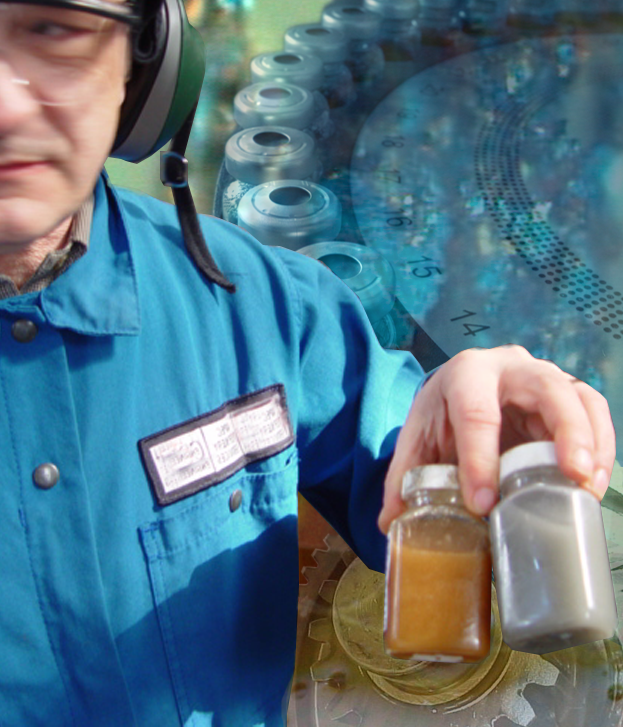Submitting Samples to the Laboratory
How to properly prepare your samples for return to the WearCheck laboratory using the new QR-coded sample information forms and poly pack mailer.

Your primary concern as a business is to be profitable. All too often, these days, this requires an increase in profit through a reduction in costs. A well run condition monitoring program will achieve a substantial reduction in manufacturing costs. WearCheck's oil and wear particle analysis packages offer you condition monitoring for your industrial systems. A plant survey to identify essential and critical machines will allow you to assess your analysis needs. WearCheck offers three levels of analysis, from basic to advanced test kits, to meet your condition monitoring requirements.
WearCheck's oil and wear particle analysis packages cover all three areas of analysis. An assessment of the oil condition reveals whether the system oil is ready to be changed, or if it is fit for further service. Save money by maximizing your oil change out intervals with the confidence that condition monitoring provides. Detection of ingressed contaminants from the manufacturing environment, including process contaminants, dirt, and water alerts you in time to perform filtration service, saving the oil and avoiding unnecessary wear. When the oil condition and contamination is reduced by routine monitoring, system wear will be minimized. WearCheck's analysis can detect subtle changes in the levels of wear metals present in the system oil. Failures due to worn out components can be avoided long before those components are worn out of specification.
A WearCheck Technical Representative will analyse your plant equipment list, and recommend the proper test kits for each machine. WearCheck provides you with clear and concise directions, forms and sample bottles needed to submit samples to the WearCheck laboratory. After you have taken a small sample of oil from the system, simply fill out an information sheet and submit it with your sample to the laboratory.
WearCheck's oil and wear particle analysis is effectively used today for a broad range of systems operating in a wide variety of industries including hydraulic systems, governor systems, gear extruders, natural gas turbines, industrial gear and bearing systems, and refrigeration and other compressors.
| Test | Test Method | Description | IND 1 | IND 2 | IND 3 |
|---|---|---|---|---|---|
 |
ICP Analysis ASTM D5185 |
Determines the parts per million (ppm) of all wear metals (Fe, Cr, Ni, Pb, Cu…), contaminants (Si, Na, K….), and additives (Ca, P, Zn, Mg, Mo…). | |||
 |
Viscosity ASTM D445/D7279 |
Determine the viscosity of the oil at 40°C (non-engine), or 100°C (engine) to determine if oil is still within specification. High viscosity can indicate oxidation, low viscosity can indicate contamination, improper make-up oil. | |||
 |
Visual Screen WC Method |
A picture of both the oil color/clarity and the bottom of the sample bottle are taken, and any level of contamination, visual oil problems or visible wear debris of the oil is recorded. | |||
 |
Acid Number ASTM D664/D974/D8045 |
Determines overall acidity (AN) of the oil which is an indication of degradation. Single best test to determine change-out interval. AN for non-engine oil samples. | |||
 |
Base Number ASTM D2896/D4739/D8321 |
Determines remaining alkilinity (BN) of the oil which is an indication of degradation. Single best test to determine change-out interval. BN test is for engine oil samples. | |||
 |
Water Content ASTM D6304 |
Determines level of moisture or water contamination in the oil. | |||
 |
Particle Count ASTM D7647 |
Determine cleanliness levels of oil to ISO4406:1999. High particle count levels can indicate gross contaminant ingress, wear, filter by-pass or all of these issues. | |||
 |
PQ Index ASTM D8184 |
Provide a rapid indication of metallic debris in an oil sample. Detect ferrous wear debris that may be missed by spectrometric analysis. | |||
 |
Ferrography ASTM D7690 |
A detailed morphological analysis of the wear debris particles suspended in the oil. A-Ferr can determine the type of wear process and cause of wear in a lubricated system. |
Check with your local WearCheck laboratory regarding which specific ASTM test methods are utilized.
- Test included with test package.
- Two (2) of the following test(s) included with this test package.
How to properly prepare your samples for return to the WearCheck laboratory using the new QR-coded sample information forms and poly pack mailer.
How not to submit samples to the laboratory","Common issues with samples submitted to the WearCheck laboratory are reviewed. Sample issues cause delays, and slow down the sample layout process. Please ensure that you are completing your sample forms, and properly packing your sample when sending them to the WearCheck laboratory.
Sales brochure on WearCheck's Industrial Oil Analysis Prorgrams....
How to use the WearCheck Oil Analysis app to submit samples using an iOS or Android smart device (phone / tablet)
WearCheck Industrial Analysis includes everything to set-up a complete Industrial analysis program. When you purchase a WearCheck Industrial analysis program you will receive our simplified sample kits (QR-coded bottles & sample forms with mailing packs). All WearCheck Industrial analysis programs include laboratory testing, sample diagnosis and recommendations, sample report, and access to our patented WebCheck™ system, and companion mobile application to manage your Industrial analysis program.
WearCheck offers additional programs for Fleet Vehicles, Off-Road Construction, Mobile Equipment, Marine Equipment, Wind Turbine Industry, Aviation/Avionics Systems, Advanced Oil Monitoring, Coolant Analysis, Diesel/Marine/Jet Fuel Analysis, Thermal/Heat Transfer Fluid Analysis, Transformer Fluid Analysis, Grease Analysis, Wear Particle Analysis, Honeywell TPE-331/TFE-731 SOAP Service.